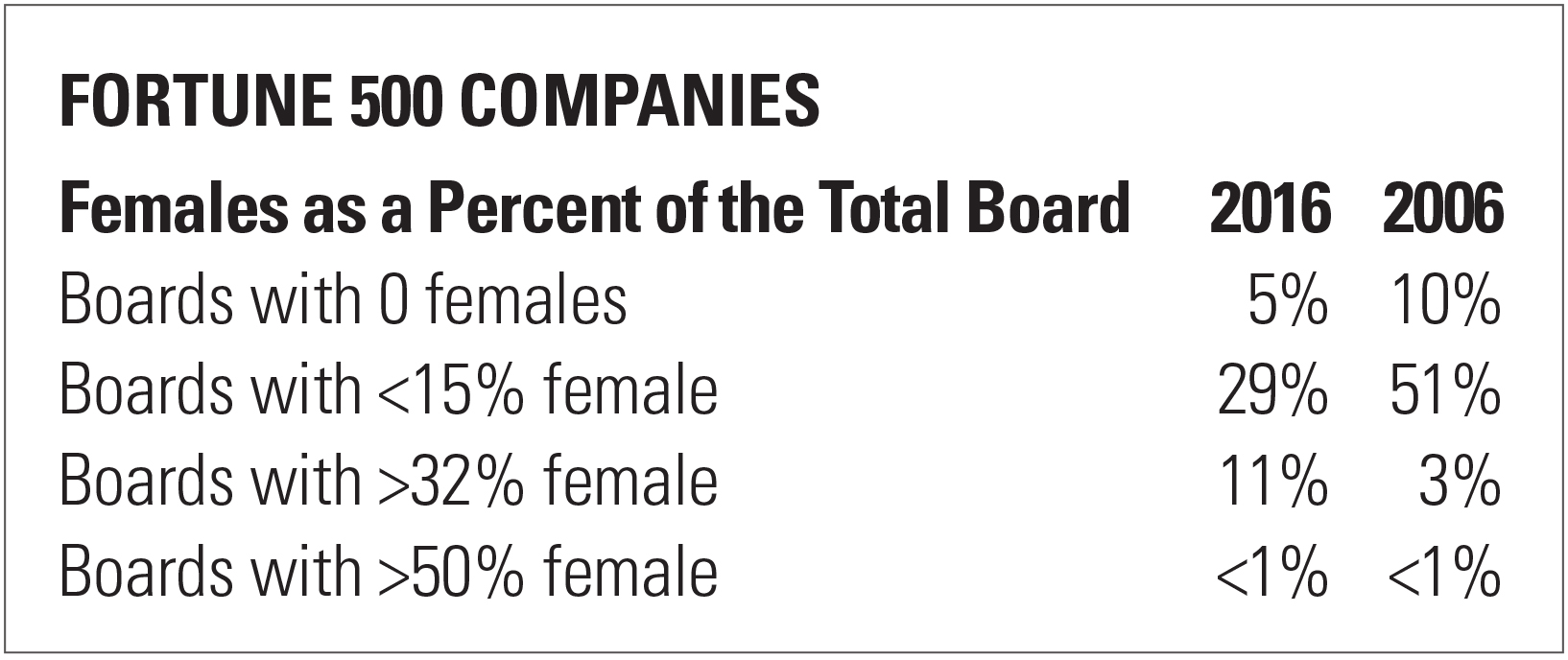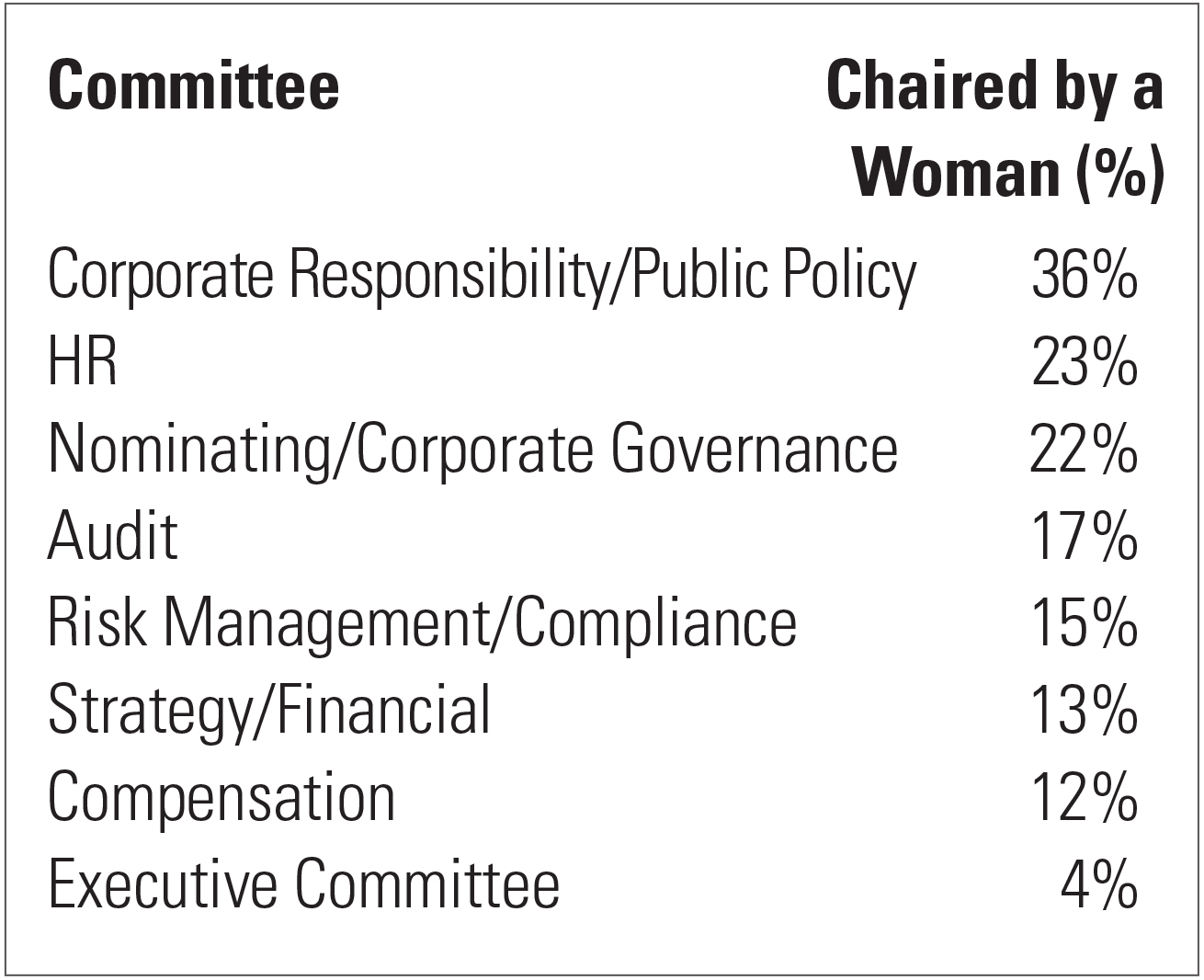In the past decade, the state of women on boards has improved. With significant interest and attention focused on the number of women who sit on boards, there has been a shift in the Fortune 500 with the percentage of boards that are now more than 32% female having almost quadrupled in that time. While some will look at the trend positively, others will point to the fact that there was only one board in both 2006 and 2016 with more than 50% of its members being female.
 Moving beyond inclusion
Moving beyond inclusion
While the debate continues regarding the pace at which progress should occur, we have begun researching a different but related topic — the roles of the women who are on boards. While being admitted to a board is a significant event, not all roles on boards are created equal, and therefore aren't endowed with equal influence. Those individuals who serve as the board chair, lead independent director, audit committee chair, nominating/governance chair, and/or compensation committee chair tend to have significant sway. This is because they serve in key leadership positions that can have influence over important board decisions such CEO selection, who is on the slate of future board members, how executive compensation is structured to align management practices with shareholder interests, and so on.
To better understand the status of female board members and the potential influence they wield, we investigated the roles of the women who sat on the 2016 Fortune 500 companies. (Note: We pulled the names of the companies from the 2016 Fortune 500 list, but the data were pulled from proxies filed in 2015 and 2016 because of the timing of the analysis.) Beyond the core committees mentioned above, there are several additional committees that some boards include such as public policy, human resources, sustainability, technology, patient safety, investment and so on. Women tend to be more likely to chair these more specialized committees than the core committees.
 There are a couple of caveats with this analysis. Not all boards have the same name for the committees and some combine committees. Many don't have the non-core committees. For example, the sample for corporate responsibility and public policy was small so we combined them.
There are a couple of caveats with this analysis. Not all boards have the same name for the committees and some combine committees. Many don't have the non-core committees. For example, the sample for corporate responsibility and public policy was small so we combined them.
The findings are interesting, however, because with roughly 20% female board members, women arebeginning to ascend to key roles. However, leadership on core committees lags the more specialized committees, where a woman chairs more than one-third of corporate responsibility/public policy committees, for example. In contrast, only 5% of boards have a female chair, and almost half those are also the CEO. This suggests that the best path for a female to become chair is by being the firm's CEO. Of the core committees, women are most likely to chair the nominating/corporate governance committee and least likely to chair the executive committee.
 Why are there not more women in key leadership board roles? There are several potential reasons. First, the more women on the board, the greater the likelihood that they ascend to key positions. For example, when boards are 30% or more female, the chair of the board is more likely to be female (14% rather than less than 4% for boards that are less than 30% female). Second, the roles that women play on boards should be determined, in part, by the skill set they bring. If more boards appoint specialist females (i.e., human resources, public policy, corporate responsibility), it follows that these women are more likely to ascend to specialist committee leadership positions. Third, the non-core committees may be considered more training and growth opportunities and therefore serve as a stepping stone to the more central committees. Fourth, there is often a preference that a former/sitting CEO chair committees. If there are fewer CEO-experienced women serving on boards, it may make it more difficult for them to ascend to a chair position.
Why are there not more women in key leadership board roles? There are several potential reasons. First, the more women on the board, the greater the likelihood that they ascend to key positions. For example, when boards are 30% or more female, the chair of the board is more likely to be female (14% rather than less than 4% for boards that are less than 30% female). Second, the roles that women play on boards should be determined, in part, by the skill set they bring. If more boards appoint specialist females (i.e., human resources, public policy, corporate responsibility), it follows that these women are more likely to ascend to specialist committee leadership positions. Third, the non-core committees may be considered more training and growth opportunities and therefore serve as a stepping stone to the more central committees. Fourth, there is often a preference that a former/sitting CEO chair committees. If there are fewer CEO-experienced women serving on boards, it may make it more difficult for them to ascend to a chair position.
While boards are continuing to make progress in terms of the number of women on boards, future measures will go beyond presence to consider the roles that women play on boards, and consequently, their ability to influence outcomes. The value of bringing greater demographic diversity onto boards is that it serves as a proxy for diversity of experience, which can lead to a wider breadth of considerations and problem solving approaches that should help to improve the quality of decisions made, and their impact on firm outcomes. If this is the case, then women ascending to key leadership board positions are worth measuring and understanding.
Kimberly A. Whitler, Ph.D., is an assistant professor of business at the University of Virginia's Darden School of Business, advisory board member of Harte Hanks, and Forbes contributor following a nearly 20-year career as general manager and chief marketing officer in the CPG and retailing industries. Deb Henretta is an independent board director on four public boards, Corning, Meritage Homes, NiSource and Staples, board advisor to Godiva and senior advisor to two private companies (G100 and General Assembly), following a successful 30-year career at Procter & Gamble where she served as group president of several multi-billion dollar businesses.



